Financial Institutions in Emerging Markets: Challenges Report
VerifiedAdded on 2023/01/09
|23
|7196
|74
Report
AI Summary
This report analyzes the challenges faced by financial institutions in emerging markets, focusing on the impact of economic growth, technological advancements, and changing customer expectations. It explores market uncertainties, including central bank policies, global instability, and the rise of FinTech. The study investigates key issues such as consumer demands, the impact of government-owned banks, the effects of macroeconomic policy failures, and the influence of inflation and instability on bank performance. The report highlights the need for financial institutions to adapt to technological changes, address customer demands, and navigate the complexities of emerging markets to remain competitive and sustainable. It also discusses the significance of international risk management, the role of innovation in banking services, and the impact of peer rivalry and government-owned banks on the financial landscape.
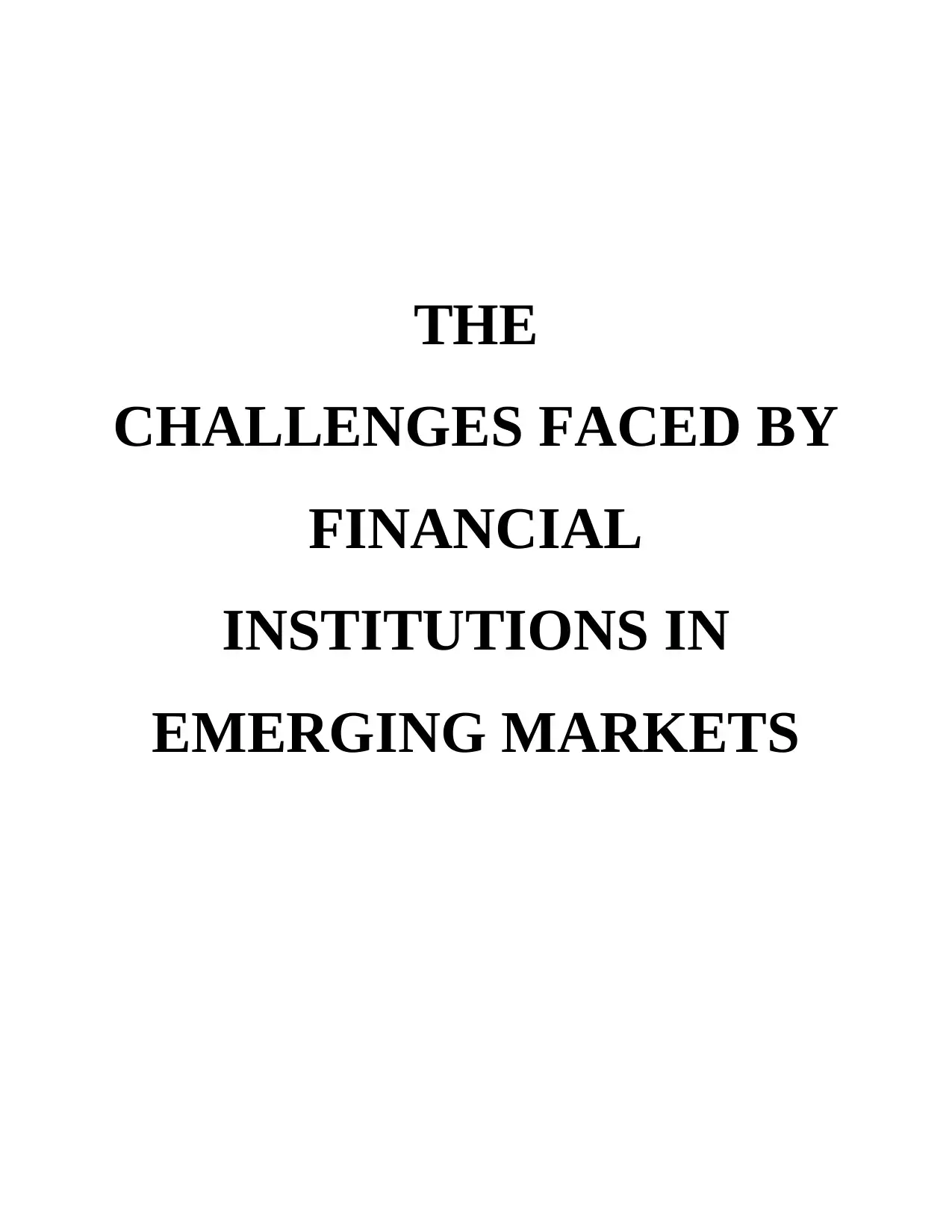
THE
CHALLENGES FACED BY
FINANCIAL
INSTITUTIONS IN
EMERGING MARKETS
CHALLENGES FACED BY
FINANCIAL
INSTITUTIONS IN
EMERGING MARKETS
Paraphrase This Document
Need a fresh take? Get an instant paraphrase of this document with our AI Paraphraser
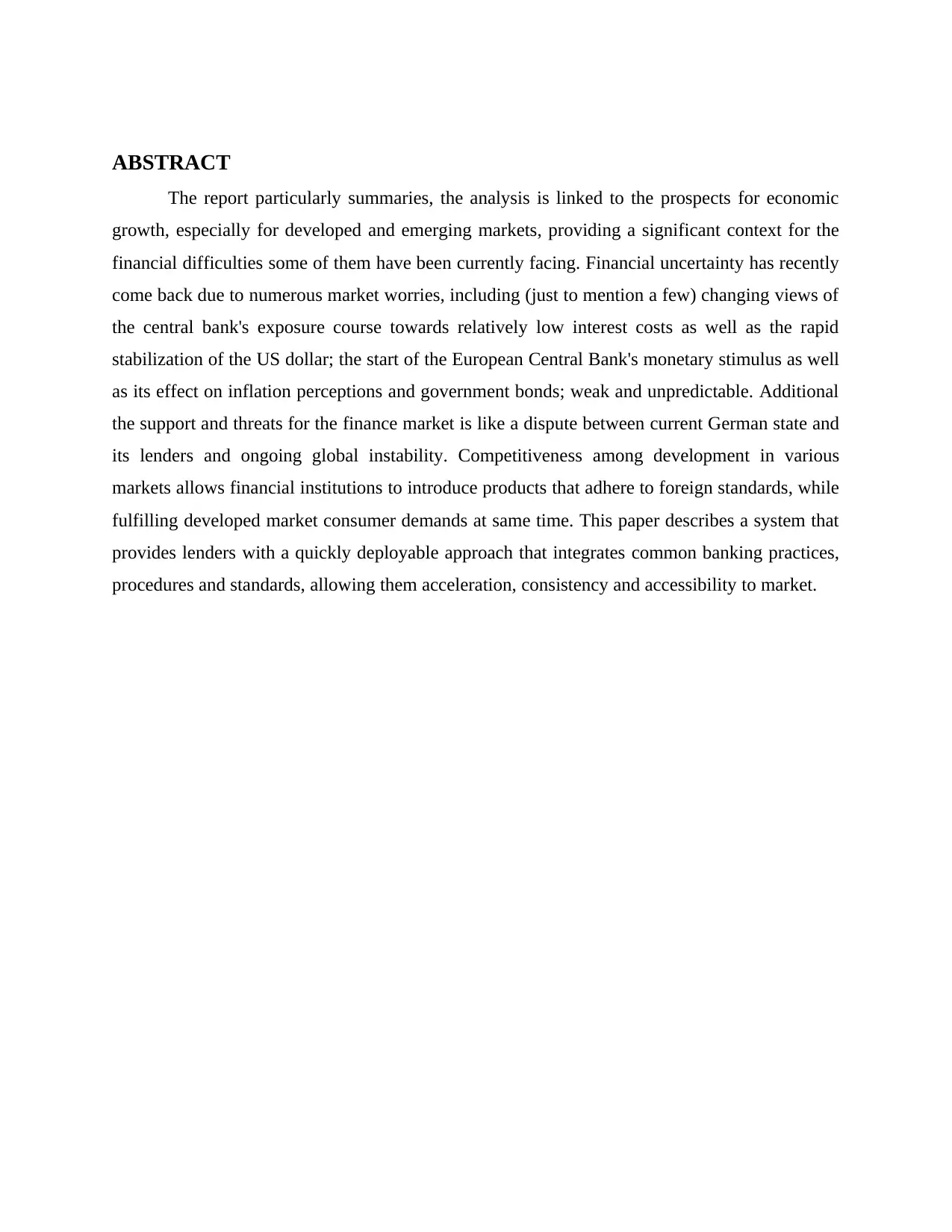
ABSTRACT
The report particularly summaries, the analysis is linked to the prospects for economic
growth, especially for developed and emerging markets, providing a significant context for the
financial difficulties some of them have been currently facing. Financial uncertainty has recently
come back due to numerous market worries, including (just to mention a few) changing views of
the central bank's exposure course towards relatively low interest costs as well as the rapid
stabilization of the US dollar; the start of the European Central Bank's monetary stimulus as well
as its effect on inflation perceptions and government bonds; weak and unpredictable. Additional
the support and threats for the finance market is like a dispute between current German state and
its lenders and ongoing global instability. Competitiveness among development in various
markets allows financial institutions to introduce products that adhere to foreign standards, while
fulfilling developed market consumer demands at same time. This paper describes a system that
provides lenders with a quickly deployable approach that integrates common banking practices,
procedures and standards, allowing them acceleration, consistency and accessibility to market.
The report particularly summaries, the analysis is linked to the prospects for economic
growth, especially for developed and emerging markets, providing a significant context for the
financial difficulties some of them have been currently facing. Financial uncertainty has recently
come back due to numerous market worries, including (just to mention a few) changing views of
the central bank's exposure course towards relatively low interest costs as well as the rapid
stabilization of the US dollar; the start of the European Central Bank's monetary stimulus as well
as its effect on inflation perceptions and government bonds; weak and unpredictable. Additional
the support and threats for the finance market is like a dispute between current German state and
its lenders and ongoing global instability. Competitiveness among development in various
markets allows financial institutions to introduce products that adhere to foreign standards, while
fulfilling developed market consumer demands at same time. This paper describes a system that
provides lenders with a quickly deployable approach that integrates common banking practices,
procedures and standards, allowing them acceleration, consistency and accessibility to market.
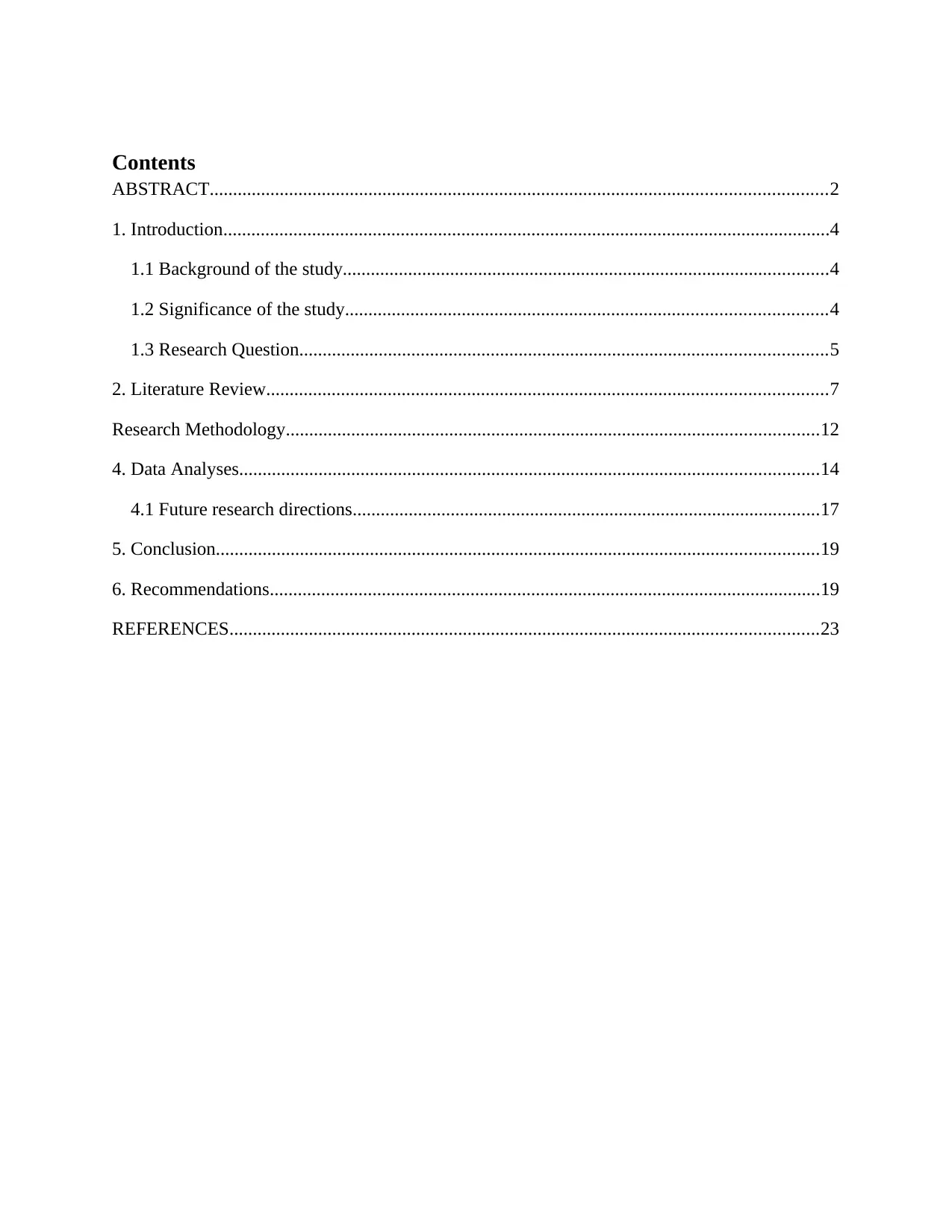
Contents
ABSTRACT....................................................................................................................................2
1. Introduction..................................................................................................................................4
1.1 Background of the study........................................................................................................4
1.2 Significance of the study.......................................................................................................4
1.3 Research Question.................................................................................................................5
2. Literature Review........................................................................................................................7
Research Methodology..................................................................................................................12
4. Data Analyses............................................................................................................................14
4.1 Future research directions....................................................................................................17
5. Conclusion.................................................................................................................................19
6. Recommendations......................................................................................................................19
REFERENCES..............................................................................................................................23
ABSTRACT....................................................................................................................................2
1. Introduction..................................................................................................................................4
1.1 Background of the study........................................................................................................4
1.2 Significance of the study.......................................................................................................4
1.3 Research Question.................................................................................................................5
2. Literature Review........................................................................................................................7
Research Methodology..................................................................................................................12
4. Data Analyses............................................................................................................................14
4.1 Future research directions....................................................................................................17
5. Conclusion.................................................................................................................................19
6. Recommendations......................................................................................................................19
REFERENCES..............................................................................................................................23
⊘ This is a preview!⊘
Do you want full access?
Subscribe today to unlock all pages.

Trusted by 1+ million students worldwide
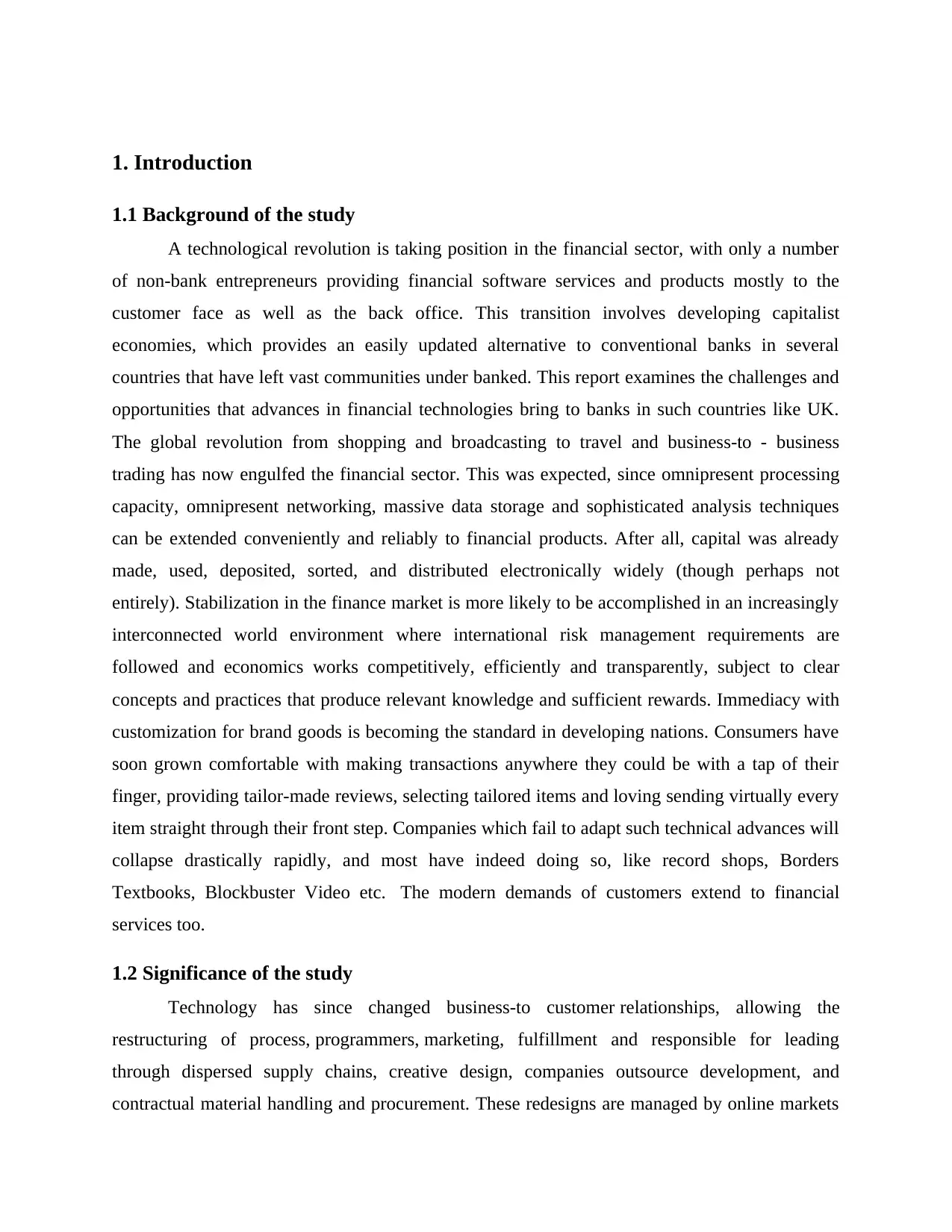
1. Introduction
1.1 Background of the study
A technological revolution is taking position in the financial sector, with only a number
of non-bank entrepreneurs providing financial software services and products mostly to the
customer face as well as the back office. This transition involves developing capitalist
economies, which provides an easily updated alternative to conventional banks in several
countries that have left vast communities under banked. This report examines the challenges and
opportunities that advances in financial technologies bring to banks in such countries like UK.
The global revolution from shopping and broadcasting to travel and business-to - business
trading has now engulfed the financial sector. This was expected, since omnipresent processing
capacity, omnipresent networking, massive data storage and sophisticated analysis techniques
can be extended conveniently and reliably to financial products. After all, capital was already
made, used, deposited, sorted, and distributed electronically widely (though perhaps not
entirely). Stabilization in the finance market is more likely to be accomplished in an increasingly
interconnected world environment where international risk management requirements are
followed and economics works competitively, efficiently and transparently, subject to clear
concepts and practices that produce relevant knowledge and sufficient rewards. Immediacy with
customization for brand goods is becoming the standard in developing nations. Consumers have
soon grown comfortable with making transactions anywhere they could be with a tap of their
finger, providing tailor-made reviews, selecting tailored items and loving sending virtually every
item straight through their front step. Companies which fail to adapt such technical advances will
collapse drastically rapidly, and most have indeed doing so, like record shops, Borders
Textbooks, Blockbuster Video etc. The modern demands of customers extend to financial
services too.
1.2 Significance of the study
Technology has since changed business-to customer relationships, allowing the
restructuring of process, programmers, marketing, fulfillment and responsible for leading
through dispersed supply chains, creative design, companies outsource development, and
contractual material handling and procurement. These redesigns are managed by online markets
1.1 Background of the study
A technological revolution is taking position in the financial sector, with only a number
of non-bank entrepreneurs providing financial software services and products mostly to the
customer face as well as the back office. This transition involves developing capitalist
economies, which provides an easily updated alternative to conventional banks in several
countries that have left vast communities under banked. This report examines the challenges and
opportunities that advances in financial technologies bring to banks in such countries like UK.
The global revolution from shopping and broadcasting to travel and business-to - business
trading has now engulfed the financial sector. This was expected, since omnipresent processing
capacity, omnipresent networking, massive data storage and sophisticated analysis techniques
can be extended conveniently and reliably to financial products. After all, capital was already
made, used, deposited, sorted, and distributed electronically widely (though perhaps not
entirely). Stabilization in the finance market is more likely to be accomplished in an increasingly
interconnected world environment where international risk management requirements are
followed and economics works competitively, efficiently and transparently, subject to clear
concepts and practices that produce relevant knowledge and sufficient rewards. Immediacy with
customization for brand goods is becoming the standard in developing nations. Consumers have
soon grown comfortable with making transactions anywhere they could be with a tap of their
finger, providing tailor-made reviews, selecting tailored items and loving sending virtually every
item straight through their front step. Companies which fail to adapt such technical advances will
collapse drastically rapidly, and most have indeed doing so, like record shops, Borders
Textbooks, Blockbuster Video etc. The modern demands of customers extend to financial
services too.
1.2 Significance of the study
Technology has since changed business-to customer relationships, allowing the
restructuring of process, programmers, marketing, fulfillment and responsible for leading
through dispersed supply chains, creative design, companies outsource development, and
contractual material handling and procurement. These redesigns are managed by online markets
Paraphrase This Document
Need a fresh take? Get an instant paraphrase of this document with our AI Paraphraser
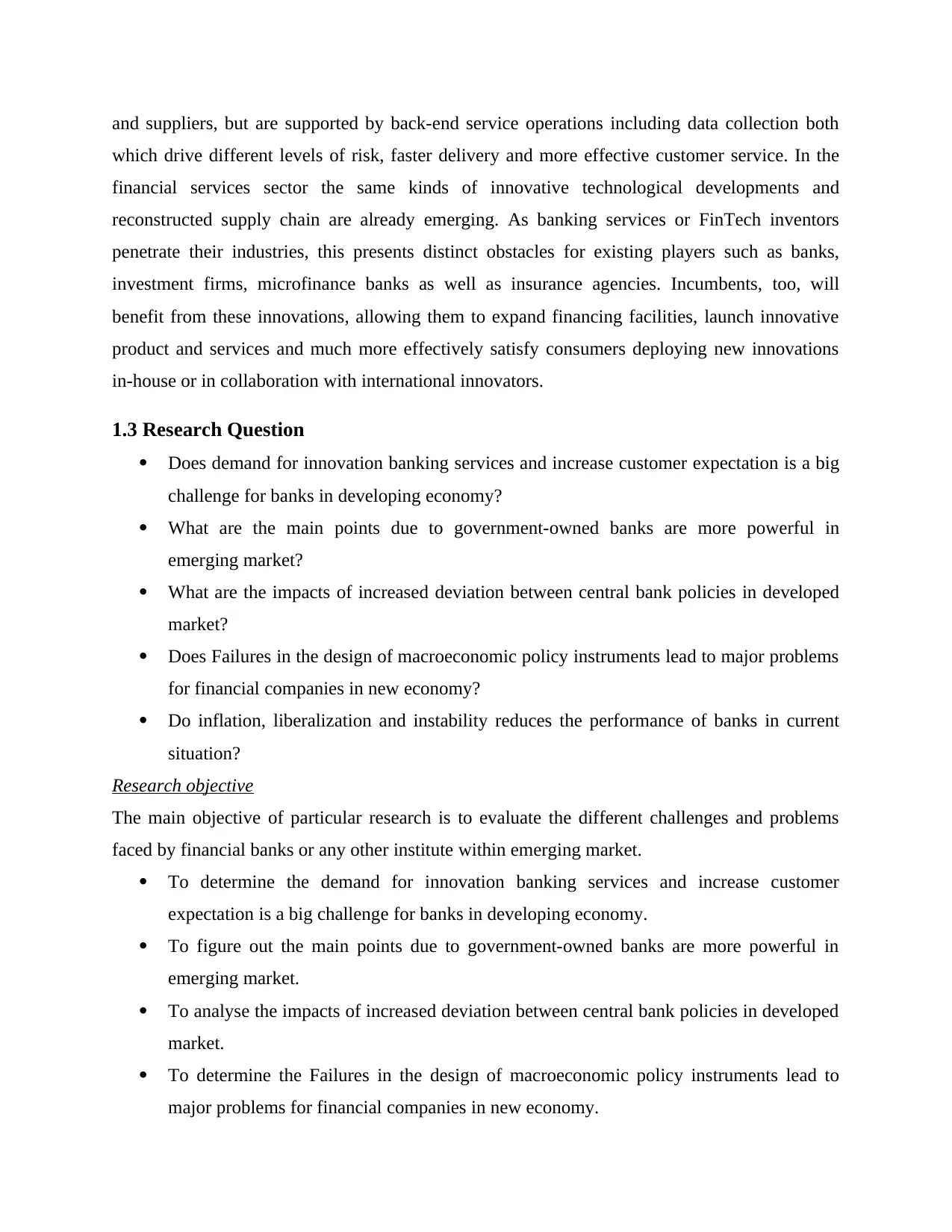
and suppliers, but are supported by back-end service operations including data collection both
which drive different levels of risk, faster delivery and more effective customer service. In the
financial services sector the same kinds of innovative technological developments and
reconstructed supply chain are already emerging. As banking services or FinTech inventors
penetrate their industries, this presents distinct obstacles for existing players such as banks,
investment firms, microfinance banks as well as insurance agencies. Incumbents, too, will
benefit from these innovations, allowing them to expand financing facilities, launch innovative
product and services and much more effectively satisfy consumers deploying new innovations
in-house or in collaboration with international innovators.
1.3 Research Question
Does demand for innovation banking services and increase customer expectation is a big
challenge for banks in developing economy?
What are the main points due to government-owned banks are more powerful in
emerging market?
What are the impacts of increased deviation between central bank policies in developed
market?
Does Failures in the design of macroeconomic policy instruments lead to major problems
for financial companies in new economy?
Do inflation, liberalization and instability reduces the performance of banks in current
situation?
Research objective
The main objective of particular research is to evaluate the different challenges and problems
faced by financial banks or any other institute within emerging market.
To determine the demand for innovation banking services and increase customer
expectation is a big challenge for banks in developing economy.
To figure out the main points due to government-owned banks are more powerful in
emerging market.
To analyse the impacts of increased deviation between central bank policies in developed
market.
To determine the Failures in the design of macroeconomic policy instruments lead to
major problems for financial companies in new economy.
which drive different levels of risk, faster delivery and more effective customer service. In the
financial services sector the same kinds of innovative technological developments and
reconstructed supply chain are already emerging. As banking services or FinTech inventors
penetrate their industries, this presents distinct obstacles for existing players such as banks,
investment firms, microfinance banks as well as insurance agencies. Incumbents, too, will
benefit from these innovations, allowing them to expand financing facilities, launch innovative
product and services and much more effectively satisfy consumers deploying new innovations
in-house or in collaboration with international innovators.
1.3 Research Question
Does demand for innovation banking services and increase customer expectation is a big
challenge for banks in developing economy?
What are the main points due to government-owned banks are more powerful in
emerging market?
What are the impacts of increased deviation between central bank policies in developed
market?
Does Failures in the design of macroeconomic policy instruments lead to major problems
for financial companies in new economy?
Do inflation, liberalization and instability reduces the performance of banks in current
situation?
Research objective
The main objective of particular research is to evaluate the different challenges and problems
faced by financial banks or any other institute within emerging market.
To determine the demand for innovation banking services and increase customer
expectation is a big challenge for banks in developing economy.
To figure out the main points due to government-owned banks are more powerful in
emerging market.
To analyse the impacts of increased deviation between central bank policies in developed
market.
To determine the Failures in the design of macroeconomic policy instruments lead to
major problems for financial companies in new economy.
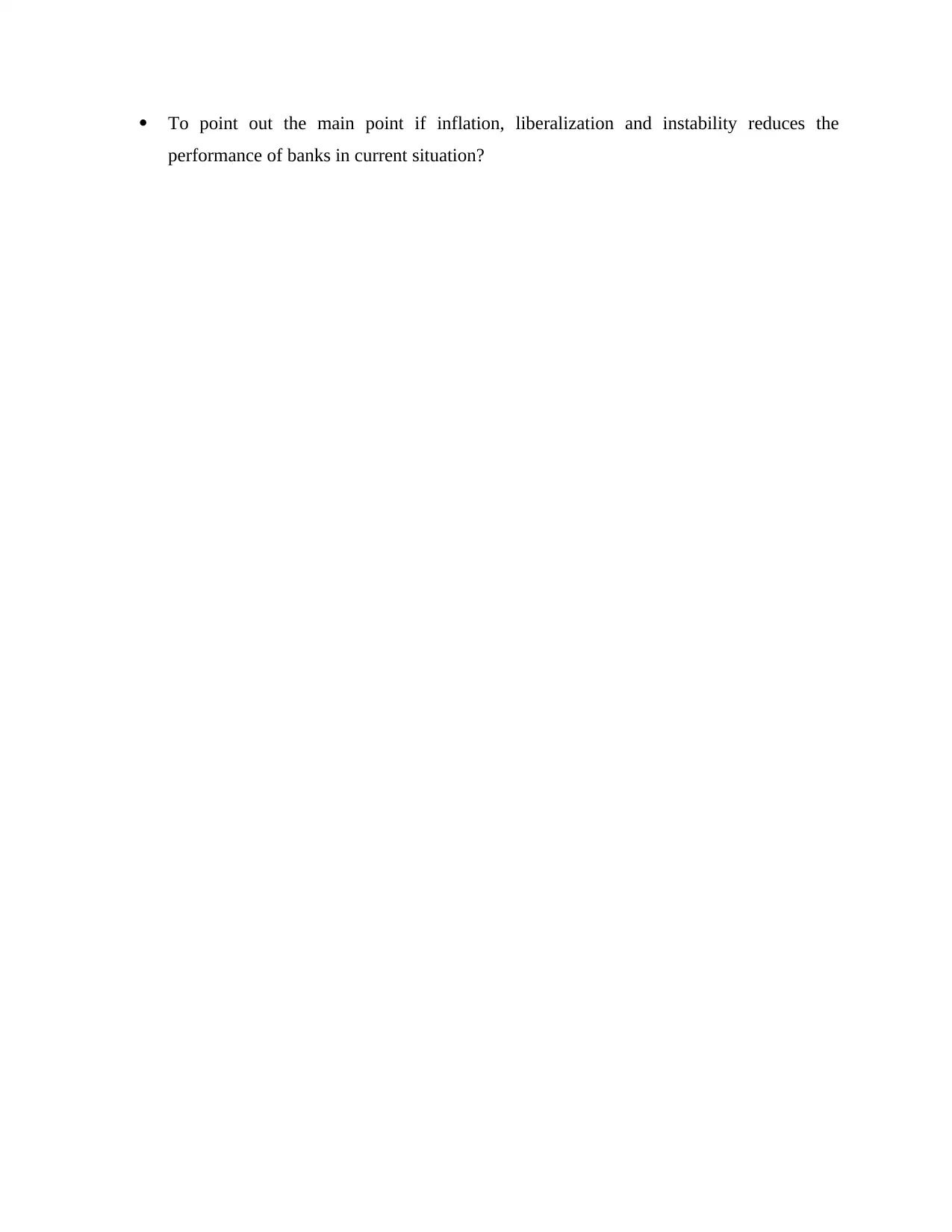
To point out the main point if inflation, liberalization and instability reduces the
performance of banks in current situation?
performance of banks in current situation?
⊘ This is a preview!⊘
Do you want full access?
Subscribe today to unlock all pages.

Trusted by 1+ million students worldwide
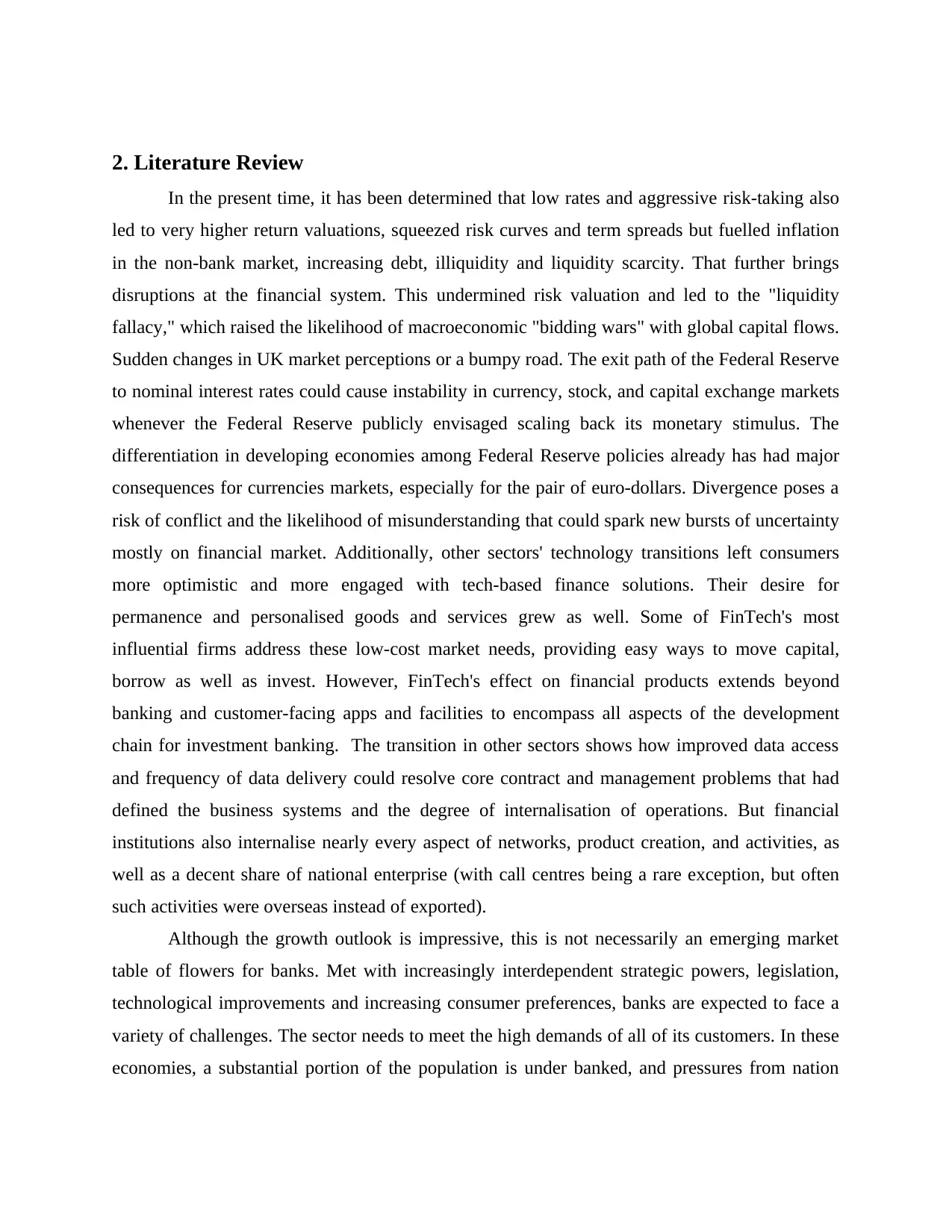
2. Literature Review
In the present time, it has been determined that low rates and aggressive risk-taking also
led to very higher return valuations, squeezed risk curves and term spreads but fuelled inflation
in the non-bank market, increasing debt, illiquidity and liquidity scarcity. That further brings
disruptions at the financial system. This undermined risk valuation and led to the "liquidity
fallacy," which raised the likelihood of macroeconomic "bidding wars" with global capital flows.
Sudden changes in UK market perceptions or a bumpy road. The exit path of the Federal Reserve
to nominal interest rates could cause instability in currency, stock, and capital exchange markets
whenever the Federal Reserve publicly envisaged scaling back its monetary stimulus. The
differentiation in developing economies among Federal Reserve policies already has had major
consequences for currencies markets, especially for the pair of euro-dollars. Divergence poses a
risk of conflict and the likelihood of misunderstanding that could spark new bursts of uncertainty
mostly on financial market. Additionally, other sectors' technology transitions left consumers
more optimistic and more engaged with tech-based finance solutions. Their desire for
permanence and personalised goods and services grew as well. Some of FinTech's most
influential firms address these low-cost market needs, providing easy ways to move capital,
borrow as well as invest. However, FinTech's effect on financial products extends beyond
banking and customer-facing apps and facilities to encompass all aspects of the development
chain for investment banking. The transition in other sectors shows how improved data access
and frequency of data delivery could resolve core contract and management problems that had
defined the business systems and the degree of internalisation of operations. But financial
institutions also internalise nearly every aspect of networks, product creation, and activities, as
well as a decent share of national enterprise (with call centres being a rare exception, but often
such activities were overseas instead of exported).
Although the growth outlook is impressive, this is not necessarily an emerging market
table of flowers for banks. Met with increasingly interdependent strategic powers, legislation,
technological improvements and increasing consumer preferences, banks are expected to face a
variety of challenges. The sector needs to meet the high demands of all of its customers. In these
economies, a substantial portion of the population is under banked, and pressures from nation
In the present time, it has been determined that low rates and aggressive risk-taking also
led to very higher return valuations, squeezed risk curves and term spreads but fuelled inflation
in the non-bank market, increasing debt, illiquidity and liquidity scarcity. That further brings
disruptions at the financial system. This undermined risk valuation and led to the "liquidity
fallacy," which raised the likelihood of macroeconomic "bidding wars" with global capital flows.
Sudden changes in UK market perceptions or a bumpy road. The exit path of the Federal Reserve
to nominal interest rates could cause instability in currency, stock, and capital exchange markets
whenever the Federal Reserve publicly envisaged scaling back its monetary stimulus. The
differentiation in developing economies among Federal Reserve policies already has had major
consequences for currencies markets, especially for the pair of euro-dollars. Divergence poses a
risk of conflict and the likelihood of misunderstanding that could spark new bursts of uncertainty
mostly on financial market. Additionally, other sectors' technology transitions left consumers
more optimistic and more engaged with tech-based finance solutions. Their desire for
permanence and personalised goods and services grew as well. Some of FinTech's most
influential firms address these low-cost market needs, providing easy ways to move capital,
borrow as well as invest. However, FinTech's effect on financial products extends beyond
banking and customer-facing apps and facilities to encompass all aspects of the development
chain for investment banking. The transition in other sectors shows how improved data access
and frequency of data delivery could resolve core contract and management problems that had
defined the business systems and the degree of internalisation of operations. But financial
institutions also internalise nearly every aspect of networks, product creation, and activities, as
well as a decent share of national enterprise (with call centres being a rare exception, but often
such activities were overseas instead of exported).
Although the growth outlook is impressive, this is not necessarily an emerging market
table of flowers for banks. Met with increasingly interdependent strategic powers, legislation,
technological improvements and increasing consumer preferences, banks are expected to face a
variety of challenges. The sector needs to meet the high demands of all of its customers. In these
economies, a substantial portion of the population is under banked, and pressures from nation
Paraphrase This Document
Need a fresh take? Get an instant paraphrase of this document with our AI Paraphraser
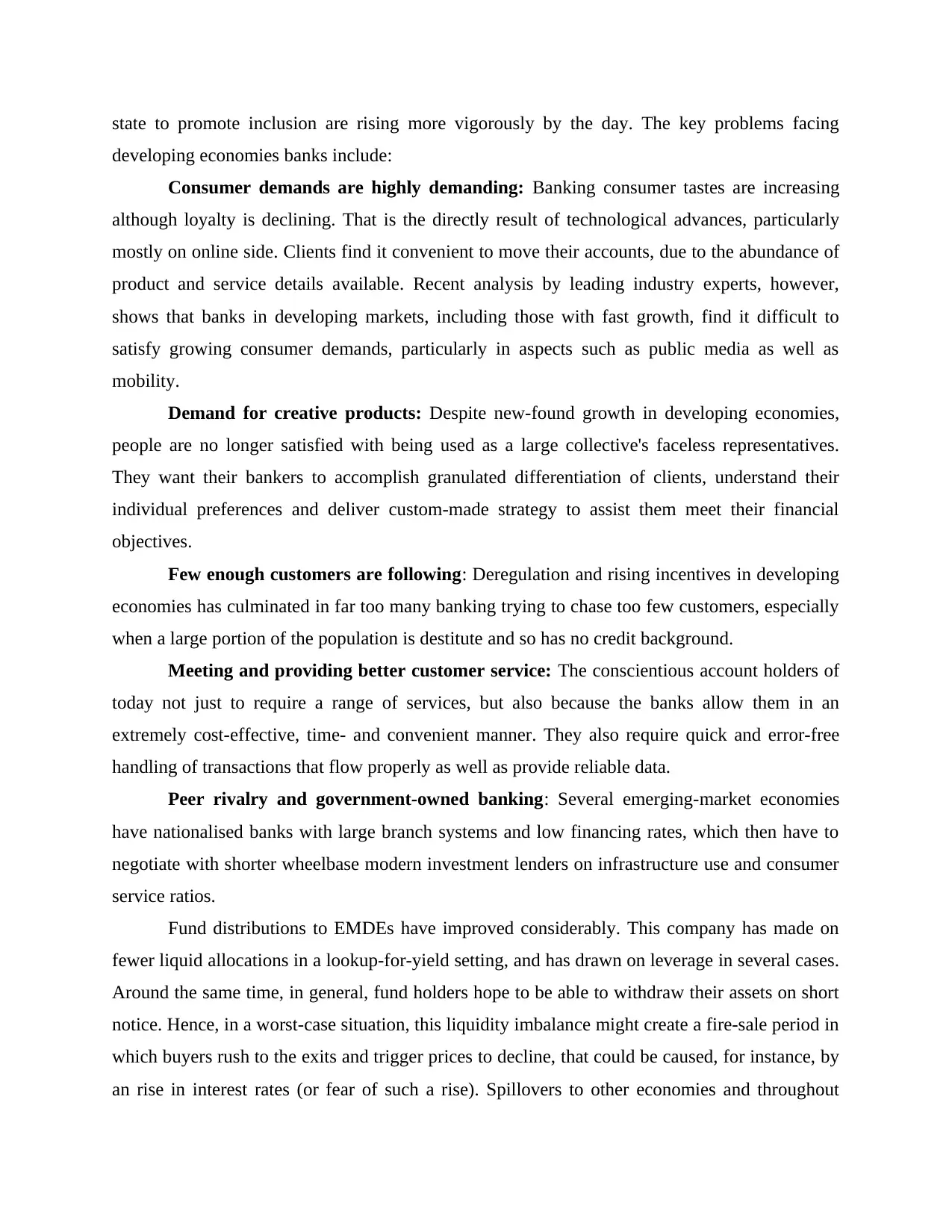
state to promote inclusion are rising more vigorously by the day. The key problems facing
developing economies banks include:
Consumer demands are highly demanding: Banking consumer tastes are increasing
although loyalty is declining. That is the directly result of technological advances, particularly
mostly on online side. Clients find it convenient to move their accounts, due to the abundance of
product and service details available. Recent analysis by leading industry experts, however,
shows that banks in developing markets, including those with fast growth, find it difficult to
satisfy growing consumer demands, particularly in aspects such as public media as well as
mobility.
Demand for creative products: Despite new-found growth in developing economies,
people are no longer satisfied with being used as a large collective's faceless representatives.
They want their bankers to accomplish granulated differentiation of clients, understand their
individual preferences and deliver custom-made strategy to assist them meet their financial
objectives.
Few enough customers are following: Deregulation and rising incentives in developing
economies has culminated in far too many banking trying to chase too few customers, especially
when a large portion of the population is destitute and so has no credit background.
Meeting and providing better customer service: The conscientious account holders of
today not just to require a range of services, but also because the banks allow them in an
extremely cost-effective, time- and convenient manner. They also require quick and error-free
handling of transactions that flow properly as well as provide reliable data.
Peer rivalry and government-owned banking: Several emerging-market economies
have nationalised banks with large branch systems and low financing rates, which then have to
negotiate with shorter wheelbase modern investment lenders on infrastructure use and consumer
service ratios.
Fund distributions to EMDEs have improved considerably. This company has made on
fewer liquid allocations in a lookup-for-yield setting, and has drawn on leverage in several cases.
Around the same time, in general, fund holders hope to be able to withdraw their assets on short
notice. Hence, in a worst-case situation, this liquidity imbalance might create a fire-sale period in
which buyers rush to the exits and trigger prices to decline, that could be caused, for instance, by
an rise in interest rates (or fear of such a rise). Spillovers to other economies and throughout
developing economies banks include:
Consumer demands are highly demanding: Banking consumer tastes are increasing
although loyalty is declining. That is the directly result of technological advances, particularly
mostly on online side. Clients find it convenient to move their accounts, due to the abundance of
product and service details available. Recent analysis by leading industry experts, however,
shows that banks in developing markets, including those with fast growth, find it difficult to
satisfy growing consumer demands, particularly in aspects such as public media as well as
mobility.
Demand for creative products: Despite new-found growth in developing economies,
people are no longer satisfied with being used as a large collective's faceless representatives.
They want their bankers to accomplish granulated differentiation of clients, understand their
individual preferences and deliver custom-made strategy to assist them meet their financial
objectives.
Few enough customers are following: Deregulation and rising incentives in developing
economies has culminated in far too many banking trying to chase too few customers, especially
when a large portion of the population is destitute and so has no credit background.
Meeting and providing better customer service: The conscientious account holders of
today not just to require a range of services, but also because the banks allow them in an
extremely cost-effective, time- and convenient manner. They also require quick and error-free
handling of transactions that flow properly as well as provide reliable data.
Peer rivalry and government-owned banking: Several emerging-market economies
have nationalised banks with large branch systems and low financing rates, which then have to
negotiate with shorter wheelbase modern investment lenders on infrastructure use and consumer
service ratios.
Fund distributions to EMDEs have improved considerably. This company has made on
fewer liquid allocations in a lookup-for-yield setting, and has drawn on leverage in several cases.
Around the same time, in general, fund holders hope to be able to withdraw their assets on short
notice. Hence, in a worst-case situation, this liquidity imbalance might create a fire-sale period in
which buyers rush to the exits and trigger prices to decline, that could be caused, for instance, by
an rise in interest rates (or fear of such a rise). Spillovers to other economies and throughout
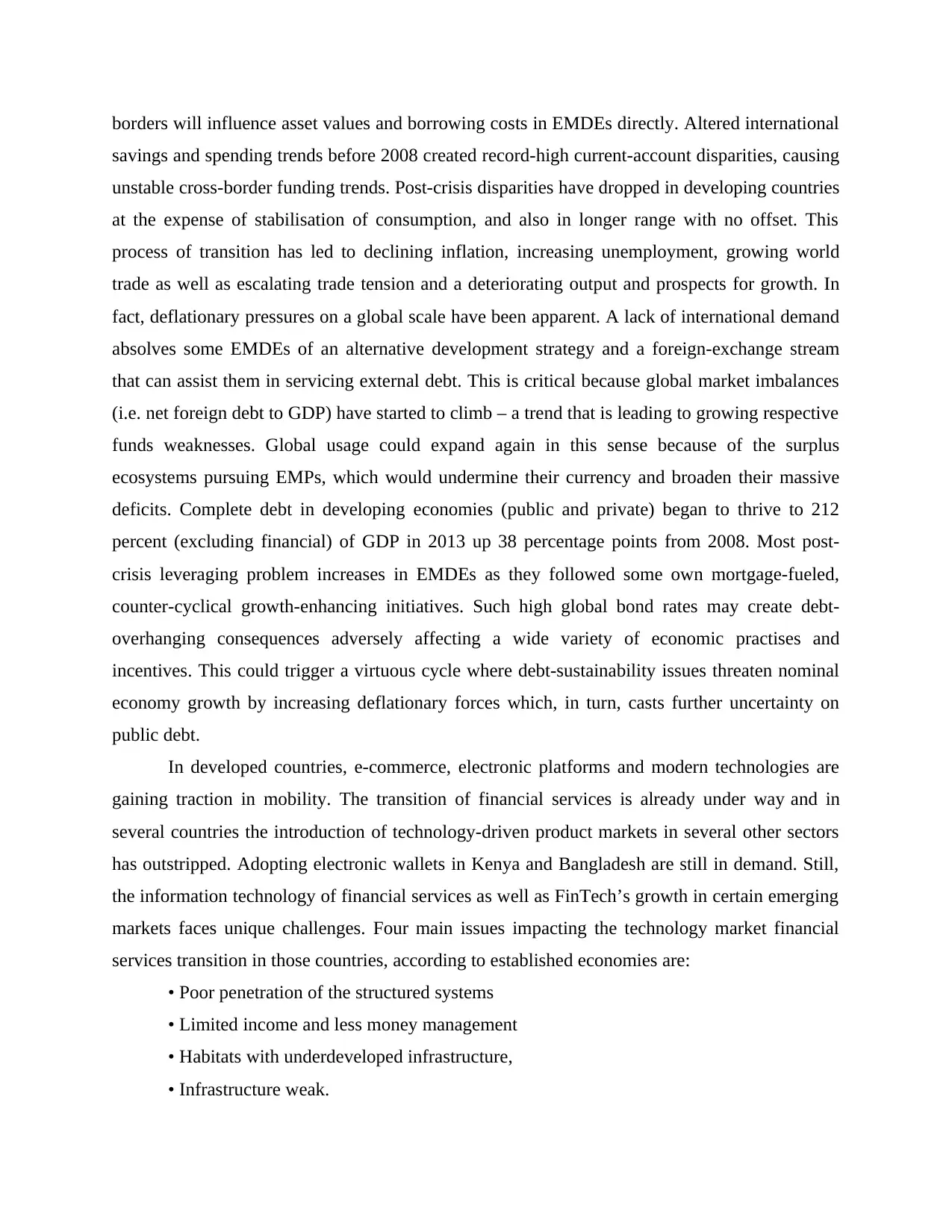
borders will influence asset values and borrowing costs in EMDEs directly. Altered international
savings and spending trends before 2008 created record-high current-account disparities, causing
unstable cross-border funding trends. Post-crisis disparities have dropped in developing countries
at the expense of stabilisation of consumption, and also in longer range with no offset. This
process of transition has led to declining inflation, increasing unemployment, growing world
trade as well as escalating trade tension and a deteriorating output and prospects for growth. In
fact, deflationary pressures on a global scale have been apparent. A lack of international demand
absolves some EMDEs of an alternative development strategy and a foreign-exchange stream
that can assist them in servicing external debt. This is critical because global market imbalances
(i.e. net foreign debt to GDP) have started to climb – a trend that is leading to growing respective
funds weaknesses. Global usage could expand again in this sense because of the surplus
ecosystems pursuing EMPs, which would undermine their currency and broaden their massive
deficits. Complete debt in developing economies (public and private) began to thrive to 212
percent (excluding financial) of GDP in 2013 up 38 percentage points from 2008. Most post-
crisis leveraging problem increases in EMDEs as they followed some own mortgage-fueled,
counter-cyclical growth-enhancing initiatives. Such high global bond rates may create debt-
overhanging consequences adversely affecting a wide variety of economic practises and
incentives. This could trigger a virtuous cycle where debt-sustainability issues threaten nominal
economy growth by increasing deflationary forces which, in turn, casts further uncertainty on
public debt.
In developed countries, e-commerce, electronic platforms and modern technologies are
gaining traction in mobility. The transition of financial services is already under way and in
several countries the introduction of technology-driven product markets in several other sectors
has outstripped. Adopting electronic wallets in Kenya and Bangladesh are still in demand. Still,
the information technology of financial services as well as FinTech’s growth in certain emerging
markets faces unique challenges. Four main issues impacting the technology market financial
services transition in those countries, according to established economies are:
• Poor penetration of the structured systems
• Limited income and less money management
• Habitats with underdeveloped infrastructure,
• Infrastructure weak.
savings and spending trends before 2008 created record-high current-account disparities, causing
unstable cross-border funding trends. Post-crisis disparities have dropped in developing countries
at the expense of stabilisation of consumption, and also in longer range with no offset. This
process of transition has led to declining inflation, increasing unemployment, growing world
trade as well as escalating trade tension and a deteriorating output and prospects for growth. In
fact, deflationary pressures on a global scale have been apparent. A lack of international demand
absolves some EMDEs of an alternative development strategy and a foreign-exchange stream
that can assist them in servicing external debt. This is critical because global market imbalances
(i.e. net foreign debt to GDP) have started to climb – a trend that is leading to growing respective
funds weaknesses. Global usage could expand again in this sense because of the surplus
ecosystems pursuing EMPs, which would undermine their currency and broaden their massive
deficits. Complete debt in developing economies (public and private) began to thrive to 212
percent (excluding financial) of GDP in 2013 up 38 percentage points from 2008. Most post-
crisis leveraging problem increases in EMDEs as they followed some own mortgage-fueled,
counter-cyclical growth-enhancing initiatives. Such high global bond rates may create debt-
overhanging consequences adversely affecting a wide variety of economic practises and
incentives. This could trigger a virtuous cycle where debt-sustainability issues threaten nominal
economy growth by increasing deflationary forces which, in turn, casts further uncertainty on
public debt.
In developed countries, e-commerce, electronic platforms and modern technologies are
gaining traction in mobility. The transition of financial services is already under way and in
several countries the introduction of technology-driven product markets in several other sectors
has outstripped. Adopting electronic wallets in Kenya and Bangladesh are still in demand. Still,
the information technology of financial services as well as FinTech’s growth in certain emerging
markets faces unique challenges. Four main issues impacting the technology market financial
services transition in those countries, according to established economies are:
• Poor penetration of the structured systems
• Limited income and less money management
• Habitats with underdeveloped infrastructure,
• Infrastructure weak.
⊘ This is a preview!⊘
Do you want full access?
Subscribe today to unlock all pages.

Trusted by 1+ million students worldwide
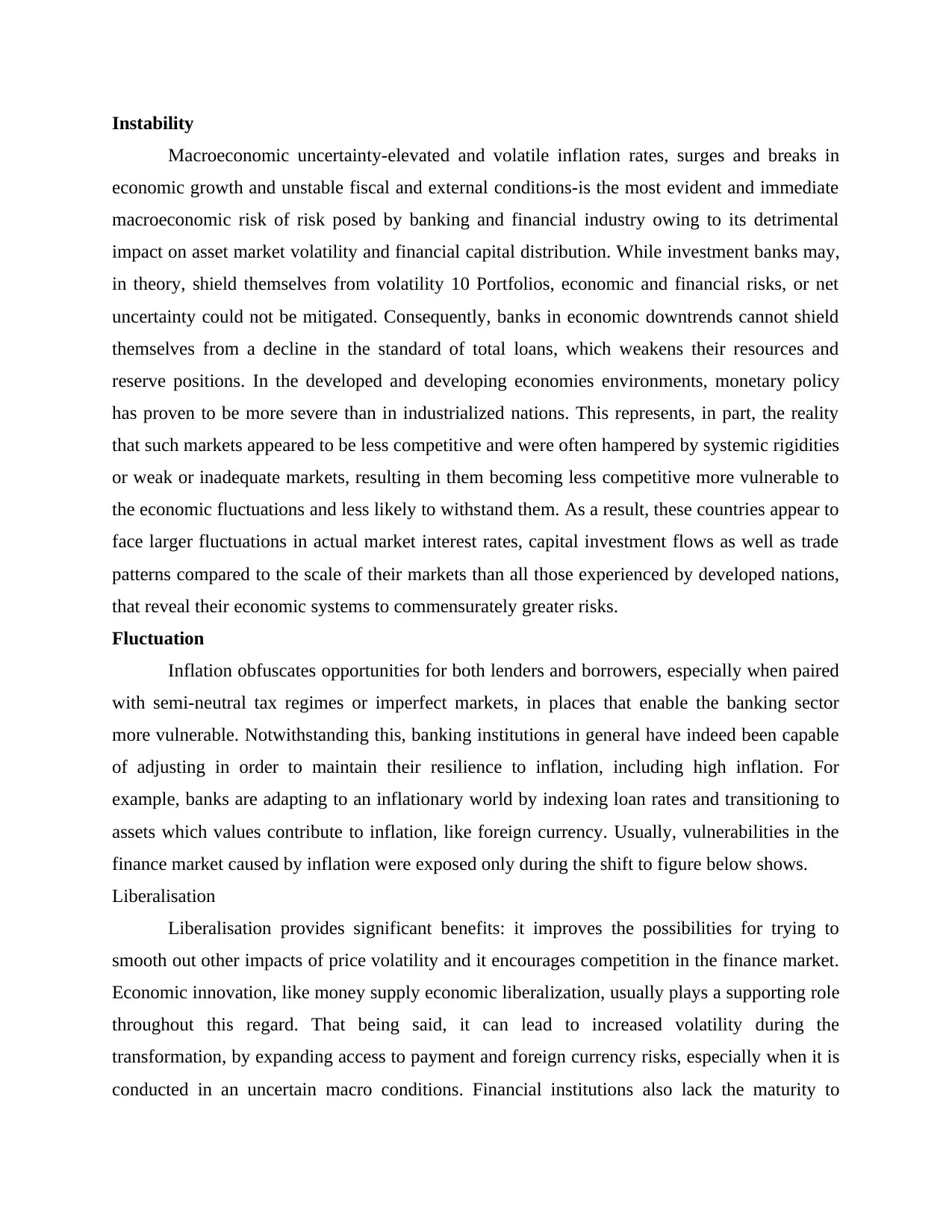
Instability
Macroeconomic uncertainty-elevated and volatile inflation rates, surges and breaks in
economic growth and unstable fiscal and external conditions-is the most evident and immediate
macroeconomic risk of risk posed by banking and financial industry owing to its detrimental
impact on asset market volatility and financial capital distribution. While investment banks may,
in theory, shield themselves from volatility 10 Portfolios, economic and financial risks, or net
uncertainty could not be mitigated. Consequently, banks in economic downtrends cannot shield
themselves from a decline in the standard of total loans, which weakens their resources and
reserve positions. In the developed and developing economies environments, monetary policy
has proven to be more severe than in industrialized nations. This represents, in part, the reality
that such markets appeared to be less competitive and were often hampered by systemic rigidities
or weak or inadequate markets, resulting in them becoming less competitive more vulnerable to
the economic fluctuations and less likely to withstand them. As a result, these countries appear to
face larger fluctuations in actual market interest rates, capital investment flows as well as trade
patterns compared to the scale of their markets than all those experienced by developed nations,
that reveal their economic systems to commensurately greater risks.
Fluctuation
Inflation obfuscates opportunities for both lenders and borrowers, especially when paired
with semi-neutral tax regimes or imperfect markets, in places that enable the banking sector
more vulnerable. Notwithstanding this, banking institutions in general have indeed been capable
of adjusting in order to maintain their resilience to inflation, including high inflation. For
example, banks are adapting to an inflationary world by indexing loan rates and transitioning to
assets which values contribute to inflation, like foreign currency. Usually, vulnerabilities in the
finance market caused by inflation were exposed only during the shift to figure below shows.
Liberalisation
Liberalisation provides significant benefits: it improves the possibilities for trying to
smooth out other impacts of price volatility and it encourages competition in the finance market.
Economic innovation, like money supply economic liberalization, usually plays a supporting role
throughout this regard. That being said, it can lead to increased volatility during the
transformation, by expanding access to payment and foreign currency risks, especially when it is
conducted in an uncertain macro conditions. Financial institutions also lack the maturity to
Macroeconomic uncertainty-elevated and volatile inflation rates, surges and breaks in
economic growth and unstable fiscal and external conditions-is the most evident and immediate
macroeconomic risk of risk posed by banking and financial industry owing to its detrimental
impact on asset market volatility and financial capital distribution. While investment banks may,
in theory, shield themselves from volatility 10 Portfolios, economic and financial risks, or net
uncertainty could not be mitigated. Consequently, banks in economic downtrends cannot shield
themselves from a decline in the standard of total loans, which weakens their resources and
reserve positions. In the developed and developing economies environments, monetary policy
has proven to be more severe than in industrialized nations. This represents, in part, the reality
that such markets appeared to be less competitive and were often hampered by systemic rigidities
or weak or inadequate markets, resulting in them becoming less competitive more vulnerable to
the economic fluctuations and less likely to withstand them. As a result, these countries appear to
face larger fluctuations in actual market interest rates, capital investment flows as well as trade
patterns compared to the scale of their markets than all those experienced by developed nations,
that reveal their economic systems to commensurately greater risks.
Fluctuation
Inflation obfuscates opportunities for both lenders and borrowers, especially when paired
with semi-neutral tax regimes or imperfect markets, in places that enable the banking sector
more vulnerable. Notwithstanding this, banking institutions in general have indeed been capable
of adjusting in order to maintain their resilience to inflation, including high inflation. For
example, banks are adapting to an inflationary world by indexing loan rates and transitioning to
assets which values contribute to inflation, like foreign currency. Usually, vulnerabilities in the
finance market caused by inflation were exposed only during the shift to figure below shows.
Liberalisation
Liberalisation provides significant benefits: it improves the possibilities for trying to
smooth out other impacts of price volatility and it encourages competition in the finance market.
Economic innovation, like money supply economic liberalization, usually plays a supporting role
throughout this regard. That being said, it can lead to increased volatility during the
transformation, by expanding access to payment and foreign currency risks, especially when it is
conducted in an uncertain macro conditions. Financial institutions also lack the maturity to
Paraphrase This Document
Need a fresh take? Get an instant paraphrase of this document with our AI Paraphraser
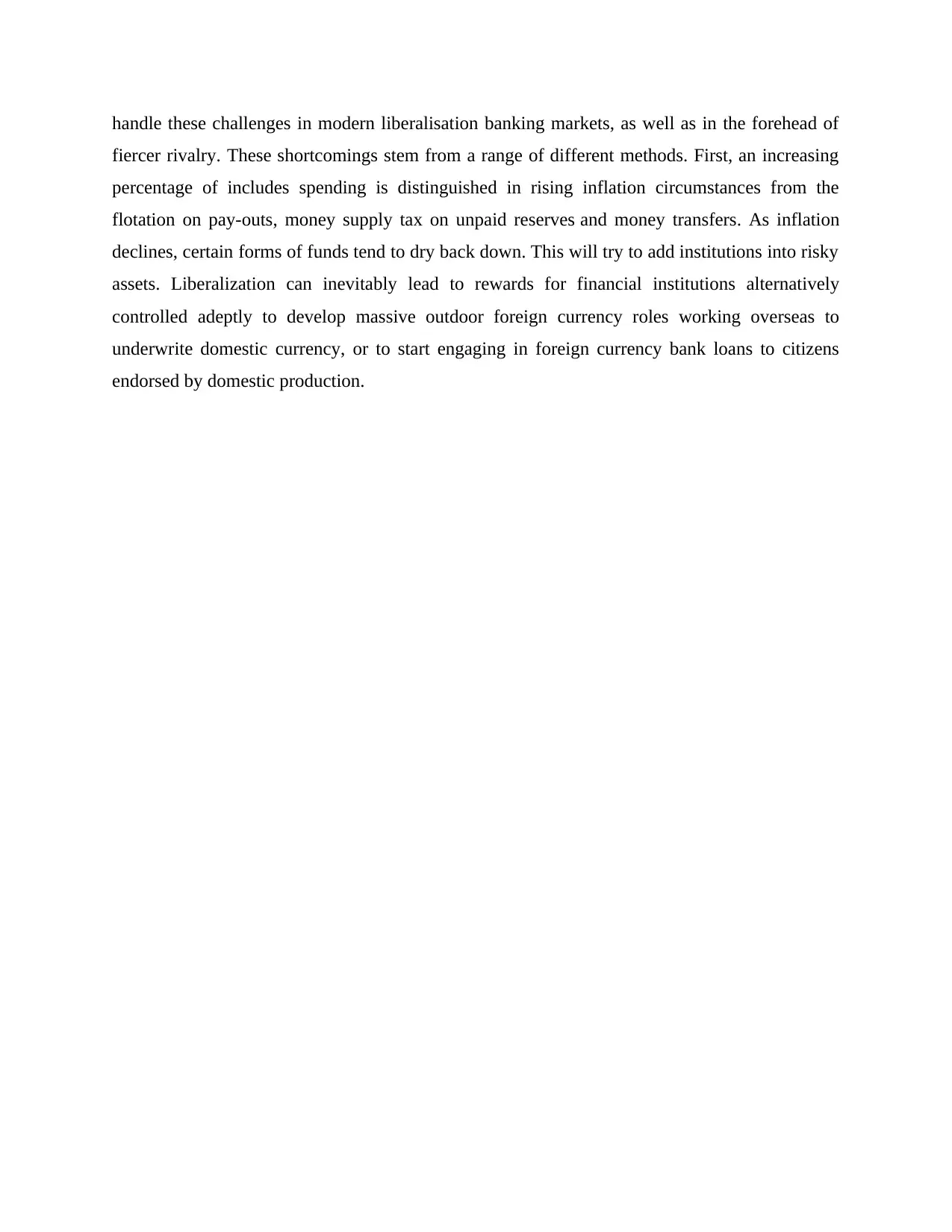
handle these challenges in modern liberalisation banking markets, as well as in the forehead of
fiercer rivalry. These shortcomings stem from a range of different methods. First, an increasing
percentage of includes spending is distinguished in rising inflation circumstances from the
flotation on pay-outs, money supply tax on unpaid reserves and money transfers. As inflation
declines, certain forms of funds tend to dry back down. This will try to add institutions into risky
assets. Liberalization can inevitably lead to rewards for financial institutions alternatively
controlled adeptly to develop massive outdoor foreign currency roles working overseas to
underwrite domestic currency, or to start engaging in foreign currency bank loans to citizens
endorsed by domestic production.
fiercer rivalry. These shortcomings stem from a range of different methods. First, an increasing
percentage of includes spending is distinguished in rising inflation circumstances from the
flotation on pay-outs, money supply tax on unpaid reserves and money transfers. As inflation
declines, certain forms of funds tend to dry back down. This will try to add institutions into risky
assets. Liberalization can inevitably lead to rewards for financial institutions alternatively
controlled adeptly to develop massive outdoor foreign currency roles working overseas to
underwrite domestic currency, or to start engaging in foreign currency bank loans to citizens
endorsed by domestic production.
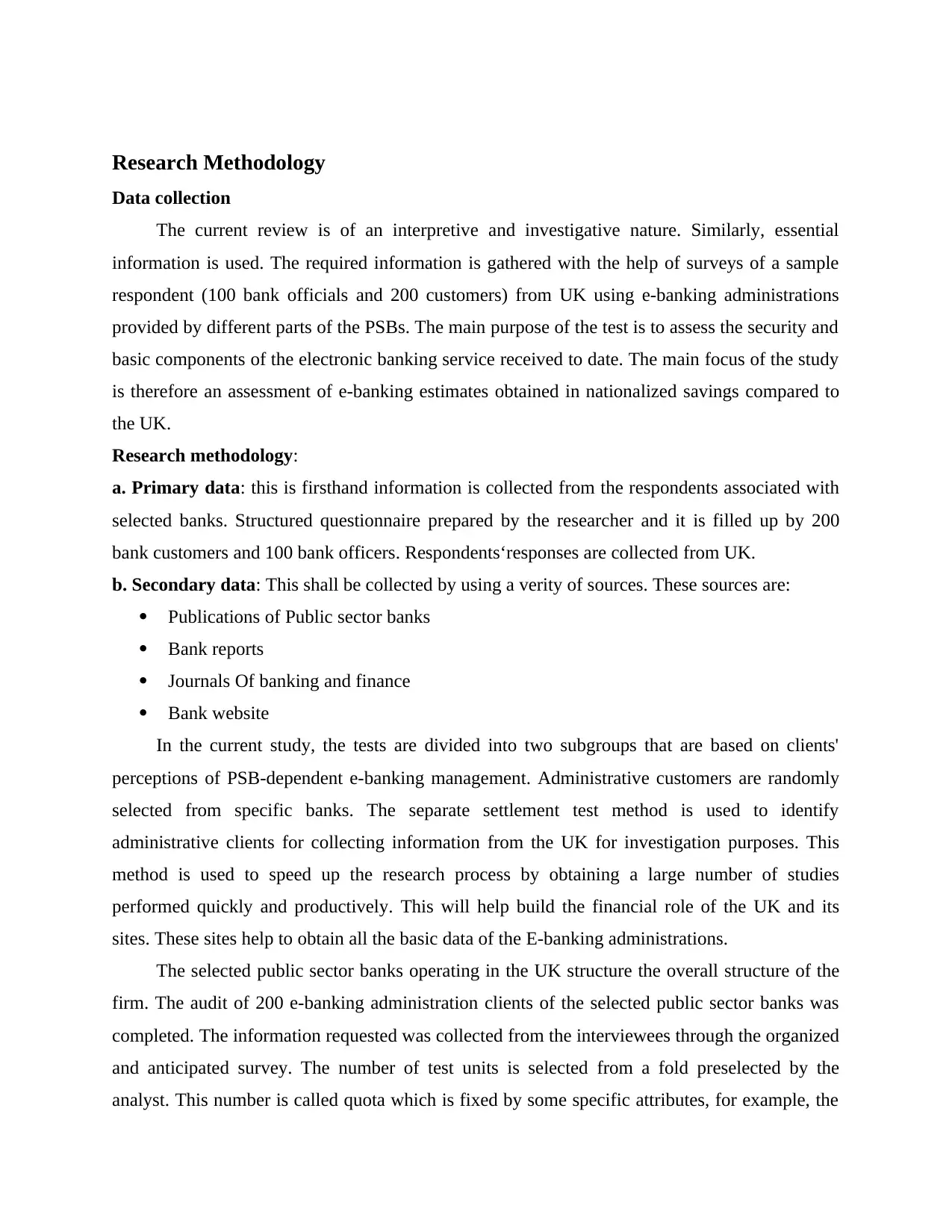
Research Methodology
Data collection
The current review is of an interpretive and investigative nature. Similarly, essential
information is used. The required information is gathered with the help of surveys of a sample
respondent (100 bank officials and 200 customers) from UK using e-banking administrations
provided by different parts of the PSBs. The main purpose of the test is to assess the security and
basic components of the electronic banking service received to date. The main focus of the study
is therefore an assessment of e-banking estimates obtained in nationalized savings compared to
the UK.
Research methodology:
a. Primary data: this is firsthand information is collected from the respondents associated with
selected banks. Structured questionnaire prepared by the researcher and it is filled up by 200
bank customers and 100 bank officers. Respondents‘responses are collected from UK.
b. Secondary data: This shall be collected by using a verity of sources. These sources are:
Publications of Public sector banks
Bank reports
Journals Of banking and finance
Bank website
In the current study, the tests are divided into two subgroups that are based on clients'
perceptions of PSB-dependent e-banking management. Administrative customers are randomly
selected from specific banks. The separate settlement test method is used to identify
administrative clients for collecting information from the UK for investigation purposes. This
method is used to speed up the research process by obtaining a large number of studies
performed quickly and productively. This will help build the financial role of the UK and its
sites. These sites help to obtain all the basic data of the E-banking administrations.
The selected public sector banks operating in the UK structure the overall structure of the
firm. The audit of 200 e-banking administration clients of the selected public sector banks was
completed. The information requested was collected from the interviewees through the organized
and anticipated survey. The number of test units is selected from a fold preselected by the
analyst. This number is called quota which is fixed by some specific attributes, for example, the
Data collection
The current review is of an interpretive and investigative nature. Similarly, essential
information is used. The required information is gathered with the help of surveys of a sample
respondent (100 bank officials and 200 customers) from UK using e-banking administrations
provided by different parts of the PSBs. The main purpose of the test is to assess the security and
basic components of the electronic banking service received to date. The main focus of the study
is therefore an assessment of e-banking estimates obtained in nationalized savings compared to
the UK.
Research methodology:
a. Primary data: this is firsthand information is collected from the respondents associated with
selected banks. Structured questionnaire prepared by the researcher and it is filled up by 200
bank customers and 100 bank officers. Respondents‘responses are collected from UK.
b. Secondary data: This shall be collected by using a verity of sources. These sources are:
Publications of Public sector banks
Bank reports
Journals Of banking and finance
Bank website
In the current study, the tests are divided into two subgroups that are based on clients'
perceptions of PSB-dependent e-banking management. Administrative customers are randomly
selected from specific banks. The separate settlement test method is used to identify
administrative clients for collecting information from the UK for investigation purposes. This
method is used to speed up the research process by obtaining a large number of studies
performed quickly and productively. This will help build the financial role of the UK and its
sites. These sites help to obtain all the basic data of the E-banking administrations.
The selected public sector banks operating in the UK structure the overall structure of the
firm. The audit of 200 e-banking administration clients of the selected public sector banks was
completed. The information requested was collected from the interviewees through the organized
and anticipated survey. The number of test units is selected from a fold preselected by the
analyst. This number is called quota which is fixed by some specific attributes, for example, the
⊘ This is a preview!⊘
Do you want full access?
Subscribe today to unlock all pages.

Trusted by 1+ million students worldwide
1 out of 23
Related Documents
Your All-in-One AI-Powered Toolkit for Academic Success.
+13062052269
info@desklib.com
Available 24*7 on WhatsApp / Email
![[object Object]](/_next/static/media/star-bottom.7253800d.svg)
Unlock your academic potential
Copyright © 2020–2025 A2Z Services. All Rights Reserved. Developed and managed by ZUCOL.





